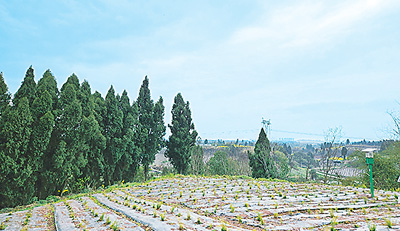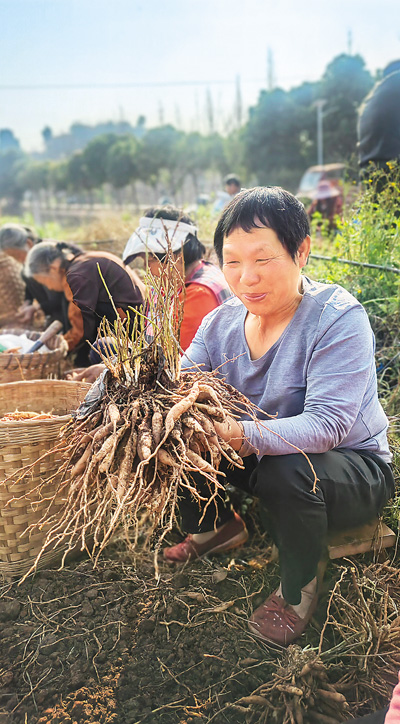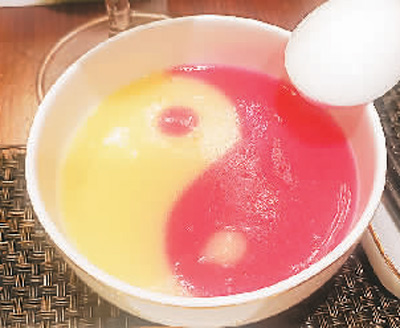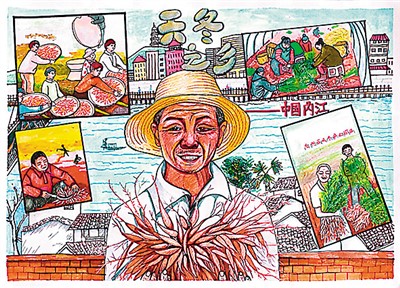 |
|
Tiandong Planting Base, Guobei Town, Dongxing District, Neijiang City.
Photographed by our reporter Zhao Xiaoxia
|
 |
|
At the Tiandong planting base in Huohua Village, Tianjia Town, villagers are sorting Tiandong.
Photographed by our reporter Xiong Jian
|
 |
|
This is a mashed potato added with winter, which is mixed with different colors to form a picture of Tai Chi, spreading Chinese medicine culture in the food.
Photographed by our reporter Wang Meihua
|
 |
|
Dongxing District Education and Sports Bureau of Neijiang City organized primary and secondary schools in the whole district to carry out "plant winter, sow hope" children's hand copying and painting activities, spread winter knowledge, and inherit Chinese medicine culture. The picture shows Zhu Haixia, a sixth grader of Shunhe Primary School in Shunhe Town, Dongxing District.
|
"Look! What is this?"
"Candied fruit in winter!"
"You like it best."
"Hmm! It's delicious. You can eat it too!"
"I left it for you."
Not long ago, such a segment appeared in the TV series "All the Way Forward" broadcast by CCTV. With the first railway built after the founding of the People's Republic of China - Chengdu Chongqing Railway as the background, the TV drama naturally has Sichuan elements. Tiandong candied fruit is a specialty of Dongxing District, Neijiang City, Sichuan Province.
The main raw material of preserved asparagus is asparagus, a genuine medicinal material in Neijiang. The planting history of wintersweet in Dongxing District can be traced back to the Tang Dynasty, more than 1400 years ago. In the New Book of Tang Dynasty, local officials recorded that Tianmendongjian (a traditional Chinese medicine prescription) was used as a local product to pay tribute. It is recorded in ancient books such as "Certificate Materia Medica" that in winter, "Sichuan is the best", mainly produced in Neijiang County (now Dongxing District, Neijiang City). According to Chinese Genuine Medicinal Materials, "Neijiang and Luzhou in Sichuan are the most suitable areas for winter".
Neijiang Asparagus is the only sweet variety in China, which can be used as both medicine and food. Tiandong Paste, Tiandong Wine, Tiandong Candied Fruit, Tiandong Soup, etc. are widely popular. The production process of preserved fruits in winter is also a provincial intangible cultural heritage in Sichuan.
Neijiang Asparagus has good taste and high grade. It contains 19 kinds of amino acids such as asparagine, and asparagus polysaccharide ABCD. The content of asparagus extract is the highest in China, reaching 94.15%. It has the effects of anti-oxidation, anti-aging, anti-tumor, and improving blood lipids. Tsumura, a Japanese Hanfang pharmaceutical company, collected data from various parts of China and found that Neijiang Tiandong was the top grade.
The winter here is a little sweet
One day in the middle of March, when the reporter came to Huohua Village, Tianjia Town, Dongxing District, he was in the harvest season of winter. The Tiandong planting base in the village is very hot and busy. Forty or fifty villagers are busy harvesting mature Tiandong.
Although busy, it is orderly.
For example, looking at this ridge, an old man took the lead and waved a hoe to dig out the winter; Four or five women followed, sitting on a small bench, holding scissors, shook off the mud at the roots, cut off the redundant roots, and put them into the basket.
"Asparagus is the root tuber of Liliaceae plant Asparagus, and also the most valuable part of Asparagus. The root system of Asparagus is very developed, and it is stuck in the soil like five fingers open. It can not be directly hoed down, and it is easy to cut its root tuber." Wu Qiuhong, deputy director of the Center for Promoting Traditional Chinese Medicine Health Industry in Dongxing District, introduced.
"Look! How well this plant bears, how many and how big it is." Aunt Li, 74, while cutting off the roots of Tiandong neatly, introduced to the reporter that they are villagers around Spark Village. The village organized workers to work in the Tiandong base, responsible for sorting out fresh Tiandong, selecting a big fat one, and leaving the smaller one to continue planting. "(Sorting) Xiantiandong is 80 cents a kilogram. The more you do, the higher your income will be. I can (choose) more than 100 kilograms a day." Aunt Li said that she earned 90 yuan yesterday when sorting Tiandong.
It was the first time for Grandma Luo, who was 70 years old, to participate in the harvest of Tiandong in Spark Village. "I haven't done it before, because Tiandong needs at least three years to harvest, which is the first harvest this year after three or four years," Grandma Luo said, pointing to a plant being cut in her hand.
"Have a taste, this is a little sweet and delicious!" Aunt Li handed a piece of Tiandong to the reporter after work. After taking over Tiandong, the skin was torn open with a gentle pull. At this time, Tiandong was plump, white, tender, translucent, and transparent. After one bite, the juice spread in the mouth, sweet, crisp, tender, and slightly bitter in the aftertaste. It didn't taste like traditional Chinese medicine, but it felt like a bit of fruit.
"The winters planted in Dongxing District are called Neijiang winters, also called 'sweet winters'. Generally speaking, traditional Chinese medicine tastes bitter. Most winters produced in other places are bitter, but the winters planted in Neijiang Dongxing are sweet." Lan Zitao, deputy director of the Publicity Department of the Dongxing District Party Committee, said.
Neijiang Asparagus is an authentic medicinal material and food material implanted into the memory of local people. Aunt Li said that in the past, Tiandong was a plant often planted in front of and behind the houses of local people. She began to plant Tiandong when she was young. Tiandong candied fruit was a snack she often ate when she was a child, and Tiandong stewed chicken was a common home dish.
Wasteland has been used
Neijiang City, located in the central and southern Sichuan Basin, is the central node of the Chengdu Chongqing double city economic circle. The winding Tuojiang River and beautiful mountains and rivers here, from temperature and precipitation to sunshine and frost free period, together create an excellent production place for genuine medicinal materials in Neijiang Tiandong.
Tiandong, called Asparagus in ancient books, is long spindle shaped, slightly curved, 5 cm to 18 cm long, yellowish white to yellowish brown on the surface, and sticky. Shennong's Herbal Classic says that Asparagus officinalis can "take it lightly for a long time, improve qi and prolong life", and has the effects of strengthening bone marrow, skin care and beauty. Ge Hong, a medical expert in the Eastern Jin Dynasty, highly praised Asparagus. In his "Emergency Recipe for Elbow Reserve", he mentioned Asparagus for five times and described that it can be used to treat "madness", "breathing and gasping", "tonifying the kidney and skin", "starving, starving and dying" and other diseases.
The Chinese Pharmacopoeia records that Tiandong mainly cures "nourishing yin and moistening dryness, clearing lung and promoting fluid production". Modern medical research shows that Tiandong has the effects of relieving cough, treating gout, moistening intestines and relieving constipation, and reducing blood sugar. According to the inspection by the authority, the average extract content of Neijiang Asparagus is 94.15%, and the single effective component D-glucose content is the best, between 13.46% and 19.41%. Both indexes are higher than those of other habitats.
With such precious genuine medicinal materials, Dongxing District regards them as a breakthrough for rural revitalization. Since 2020, the district has explored a road of rural revitalization that is "led by industry, linked with agriculture and led by agriculture, and comprehensively revitalized". At present, the whole region has planted more than 50000 mu of asparagus, accounting for about 60% of the total planting area of asparagus nationwide. More than 40 kinds of health products have been developed, and the output value of the whole industrial chain of Chinese medicine health has exceeded 1 billion yuan. Dongxing District has also won the title of "Hometown of Winter in China", and "Neijiang Tiandong" has successfully registered the national geographical indication certification trademark.
In addition to Tianjia Town, there is another town in Dongxing District that is famous for its winter. That is Guobei Town, also known as "Winter Town". In the Tiandong planting base in Qingtai Village of the town, the green seedlings of Tiandong poked their heads out of the black film, one ridge after another, and were distributed neatly. "It has been more than half a year since these film covered winters were planted." Standing at the height of the planting base, Zhou Bing, secretary of the Party Committee of Guobei Town, pointed to the winters planting site at the foot of the hillside.
"People can plant 2400 plants in one mu of land when planting Asparagus. Later, it was found that planting with such density will affect the quality of Asparagus. After repeated practice, we will reserve a space of 50 cm to 80 cm between two plants when planting Asparagus." Zhou Bing said, "Because of the overcast weather in winter, we interplanted high stalk grain crops, such as corn and sorghum, which not only played a role in shading, but also ensured food security and increased land utilization."
What makes Zhou Bing even more proud is that many of the land planted in winter in Qingtai Village is abandoned. "After the development of Tiandong industry, abandoned land has been used." He said, "We also launched the '4222' interest sharing model. That is, after the land benefits are generated, 40% of the total net profits are used for industrial upgrading; 20% are paid to villagers as dividends of land shares; 20% are used for labor dividends of villagers; and 20% are used as industrial development funds. This improves the management and protection enthusiasm of villagers."
At present, Guobei Town has established a winter traceability system, which can monitor soil and insect pests. "We are preparing to connect the data, so that we can collect information about planting, fertilization, irrigation and other aspects in real time in the future, and also ensure the quality of winter," Zhou said.
Realize the development of the whole industry chain
In Neijiang and Dongxing, planting winter is closely linked with increasing farmers' income.
On the way from the foot of Huohua Village to the hillside, you can see the interplanted bergamot, some of which have already borne fruit, and workers are trimming branches for them.
Including Huohua Village, there are 4 villages in Tianjia Town planting Tiandong, and each village has about 1000 mu of land for planting Tiandong. "We have renovated more than 260 mu of abandoned land, planted 2 million asparagus plants, and interplanted 480000 Chinese medicinal materials, including bergamot and gardenia, to maximize land benefits and realize the transformation of 'wasteland' into 'good land'." Hu Jianhua, head of Tianjia Town, said that according to the characteristics of the three-year growth cycle of Tiandong and the habit of liking overcast, sorghum, corn, vegetables, etc. can also be interplanted in the field of Tiandong, Realize multiple intercropping and multiple benefits of food, medicine and vegetables.
How about multiple benefits? Hu Jianhua calculated an account for the reporter: taking "Tiandong interplanting fresh corn" as an example, if 2000 Tiandong plants are planted per mu, the yield of each plant is 4 jin, and 6 yuan per jin of fresh Tiandong, the income per mu can reach 48000 yuan; However, a winter planting and picking cycle is 3 years, which means the annual income per mu is 16000 yuan; If maize is interplanted, the income per mu will be 2000 yuan if 2000 plants are planted per mu and the yield per plant is 0.4 jin and 2.5 yuan per jin, but the income can be planted for two seasons a year, so the income of interplanting maize can reach 4000 yuan per mu per year. To sum up, the total annual output value of interplanting fresh corn in winter is 20000 yuan per mu.
Dongxing District not only stared at Tiandong in the field, but also played a big game of chess. "We have developed the TCM health industry in the whole industry chain according to the development idea of" seven in one "of seedling breeding, planting, processing, trading, product research and development, brand marketing, and health tourism." Kang Houlin, deputy director of the Standing Committee of Neijiang Municipal People's Congress and secretary of the Dongxing District Party Committee, said that Dongxing District has fully exploited the comparative advantages of "authentic efficacy and homology of food and medicine" of Neijiang Tiandong, Take the development of TCM health industry as the "No. 1 project" of the whole district.
In terms of specific measures, the first is to introduce dozens of enterprises such as Zhongjing Tianchen, and develop more than 40 ecological planting bases in Tiandong; Intensive processing and quality improvement, the construction of Chinese herbal medicine intensive processing industrial park was accelerated, and 4 enterprises were signed to settle down; Carry out the quality improvement project and GAP certification of the whole industrial chain of Winterwinter, and promote the establishment of EU international standards for Winterwinter; Promote the integration of culture, tourism, health care, and health care, cooperate with Wang Laoji and other enterprises, introduce six enterprises in the whole industry chain, register and list Tiandong Paste and Tiandong Powder in Macao, and promote them to Portuguese speaking countries; At the same time, we will build a cultural street with Chinese medicine characteristics, build an exhibition hall with the theme of winter in Neijiang, and build a demonstration base for Chinese medicine health tourism.
With this combination, the sales of Dongxing District's Tiandong series products will increase by 142.9% year on year in 2023, realizing the integrated development of the whole chain, and farmers' income will also be greatly improved. For example, through the "enterprise+cooperative+farmer" model, more than 5000 farmers are driven to participate in planting, with an average annual net income of more than 20000 yuan; More than 6000 local people, such as the left behind elderly, have been recruited to work nearby, with an annual per capita income increase of 15000 yuan. The proportion of migrant workers returning from key planting villages in winter has reached 30-40%.
The day before the reporter saw Grandma Luo, she cut roots for Tiandong in another piece of land in Spark Village. One day, she cut more than 100 jin. "(Cutting) 80 cents per kilogram." Grandma Luo earned 80 yuan. She estimated that she could do such a job for a month. "The mountain is full of plants in winter over there. When we finish here, we will change places." Grandma Luo pointed to a hillside not far away.
March is the winter season for planting. "There are few pests and diseases in winter. Generally, we can also plant in autumn and winter." In Grandma Luo's opinion, "winter makes us live a 'sweet life'."
link
Asparagus is a commonly used Chinese herbal medicine. It tastes sweet and bitter, and is cold in nature. It belongs to the lung and kidney meridians. Tiandong has the effects of nourishing yin, moistening dryness, clearing lung and reducing fire; It can cure fever due to yin deficiency, cough and hematemesis, lung impotence, lung carbuncle, sore throat, thirst, constipation, etc; It has certain curative effect for preventing and treating respiratory diseases in clinic.
In modern pharmacological research, Asparagus contains aspartame, mucin, β - sitosterol, steroidal saponins, xylose and glucose. The results of its in vitro test show that Asparagus has certain antibacterial effect, and has different inhibitory effects on anthrax, diphtheria, pneumococcus, staphylococcus, and bacillus subtilis. It has a good therapeutic effect on the prevention and treatment of various coughs caused by tracheitis, pneumonia, tuberculosis, and emphysema.
The asparagus is generally long spindle shaped, slightly curved, yellowish white, translucent, plump, hard or soft, sticky, and slightly aerated.
Extended Reading
"A jar of cloud at the head of the bed has been plucked from the head of the bed, and the ghost has been intoxicated with thick fragrance before. It's winter and the New Year is happy, and the spring fragrance of rice is not heard." These poems are from Su Shi. The name of the poem is very long. It is called "On the twelfth day of the first month of the first lunar month when he was Gengchen year old, the wine was ripe, he drank it by himself, tasted it, and then got drunk." It tells that Su Shi brewed the wine of Tianmen winter, which made the room fragrant. He was immersed in the joy of his own labor and harvest, drinking while he was drinking, his mind was misty, and he was drunk unconsciously.
According to historical records, Su Shi's method of brewing Tianmendong wine is roughly as follows: "A bucket of mellow wine, a liter of wheat starter, and five liters of good glutinous rice are used to make rice, and the juice of Tianmendong is used to soak the wine. First, the wine is dipped into the starter as usual, and the cooking is suitable for the cold temperature. Then it is brewed by frying and drinking together. The wine is ripe on the seventh day of spring and summer, and on the tenth day of autumn and winter. The wine tastes sour at the beginning, and delicious after a long pause. The rest of the wine is inferior."
Su Shi has a lot of research on medicine and health care. He brews asparagus wine for health care, which shows that he still knows the efficacy of asparagus.




